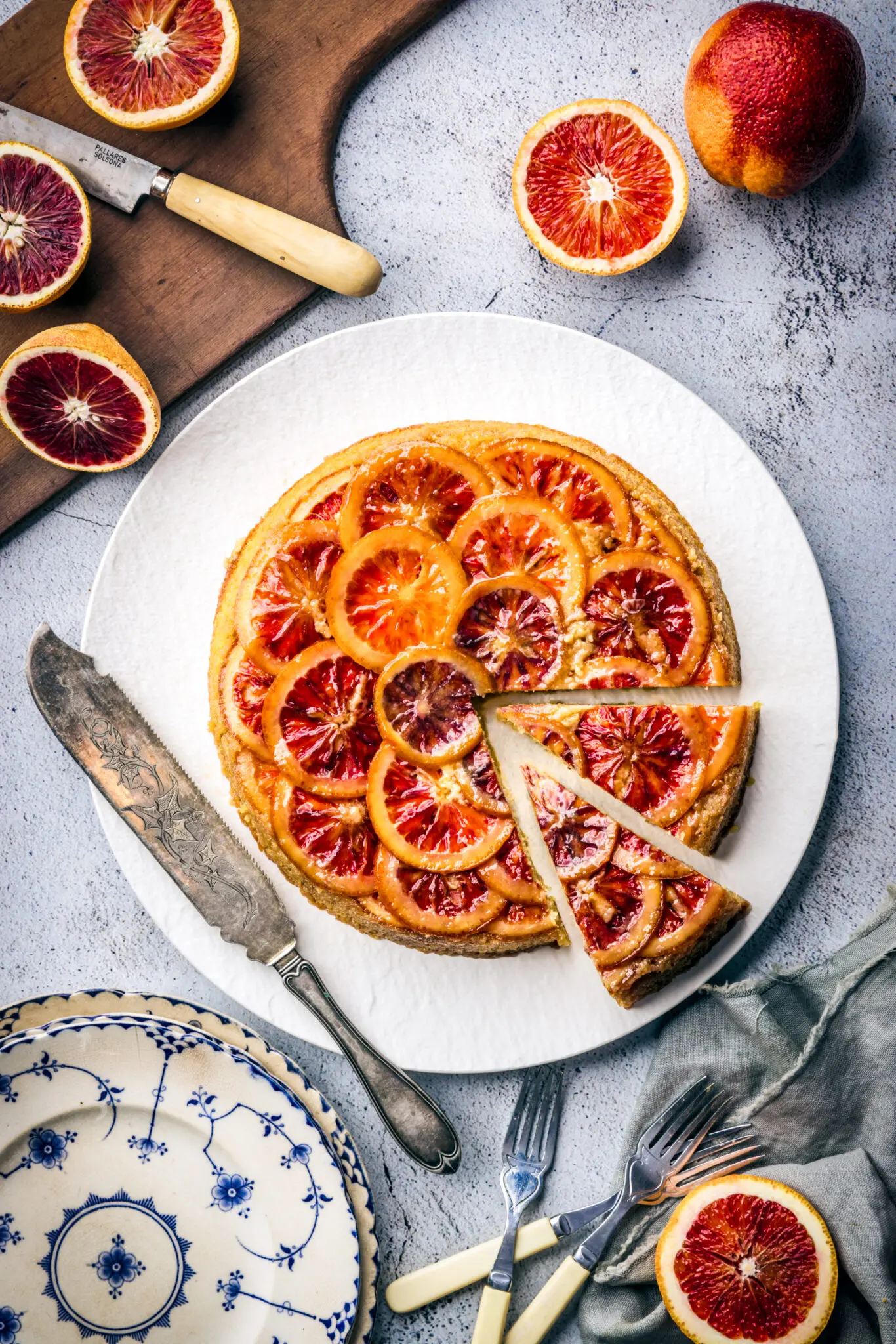
When you’re presenting a cake to your hungry guests, it’s good to have a “ta-daaa!” moment, something to add a little flair to the occasion. In the absence of a birthday candle or a mini firework, what about cocking a snook at gravity itself and turning the whole thing upside down? Upside-down cakes have been a mainstay of the dessert table for generations. We think everyone has a similar memory of at least one pineapple-and-cherry upside down cake showing up at the table at some point or another. Since citrus fruits are especially available at the moment, we decided to add blood oranges to the tradition.
One of the most popular Upside-Down Blood Orange cake recipes is a gorgeous version by Claire Saffitz, whose book Dessert Person we highly recommend. We adapted elements of her cake as well as this blood orange cake by Melissa Clark for the New York Times. Both these cakes are cornmeal-based, but we felt the citrus flavors would work well with nutty almond flour. And it does!
The almond flour keeps the cake incredibly moist, almost like a British steamed pudding (such as our Sticky Toffee Pudding). The combination of the sweet/tart oranges and the rich almonds is fantastic. If you want an even more pronounced almond flavor, you could add a little bit of almond extract in place of the vanilla. We liked the more subtle almond flavor. It’s definitely detectable, but doesn’t overpower the bright citrus notes.

We love blood oranges for their gorgeous color and tart flavor, but really, you could use any type of orange. If you wanted to try other kinds of citrus, we think a grapefruit or lemon version would be amazing.
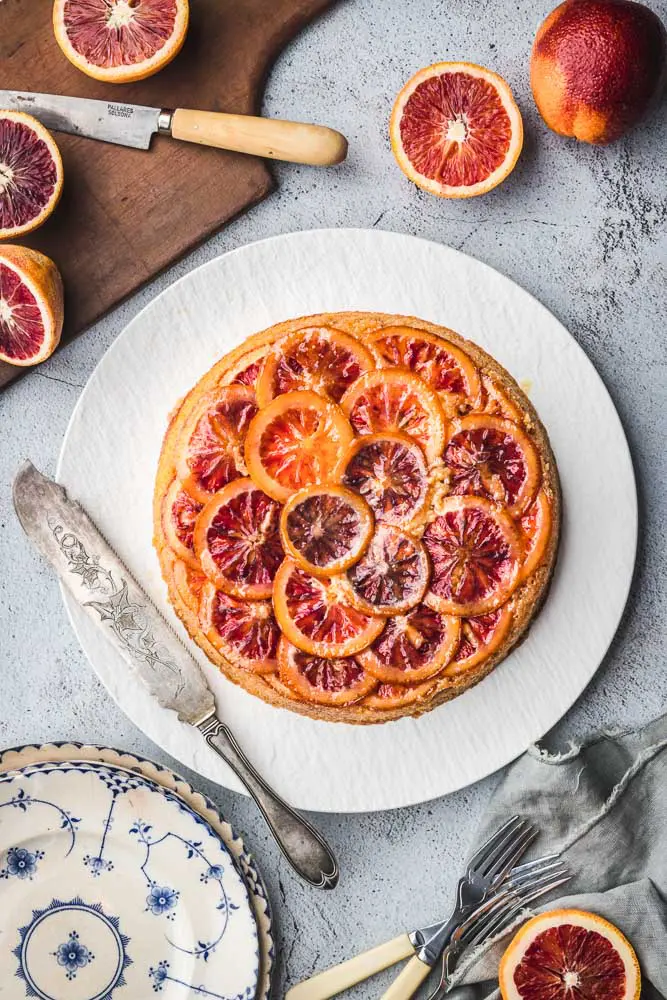
The bottom becomes the top
I know this may shock you to learn but in an upside-down cake, the bottom actually becomes the top! Quelle Suprise?! We start with a simple caramel sauce: nothing more complicated than brown sugar melted with butter and a little juice from the blood oranges. Pour into a 9-inch cake plate that has been lined with parchment and generously greased with butter or cooking spray on the bottom and sides.
Next goes the blood orange layer. Use a microplane to remove the zest from one of the oranges and set the zest aside to use in the batter. The trick to the beautiful orange slices is to cut the oranges in very thin rounds. If you have a mandoline, this is a great time to use it (carefully!). Otherwise, just use a sharp knife and try to keep the slices about 1/8-inch thick. If the slices are too thick, they won’t soften enough as the cake cooks and the skin will taste bitter.
TIP: You can also remove the skin and white pith off the oranges completely if you prefer. To do this, cut the top and bottom off to expose the fruit. Make sure to use a sharp knife, and cut the skin and white pith away, following the curve of the fruit. Then slice the oranges into rounds. If you do this, you can cut the slices a little thicker without compromising the flavor of the cake. Place the rounds on top of the caramel in an overlapping pattern, or any pattern you like.
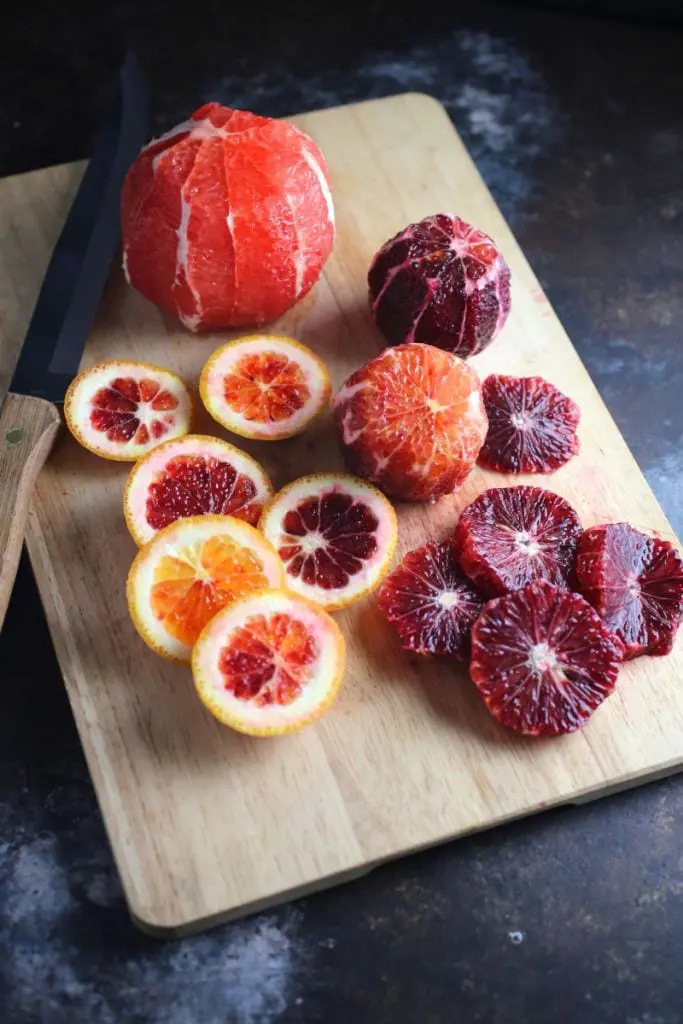
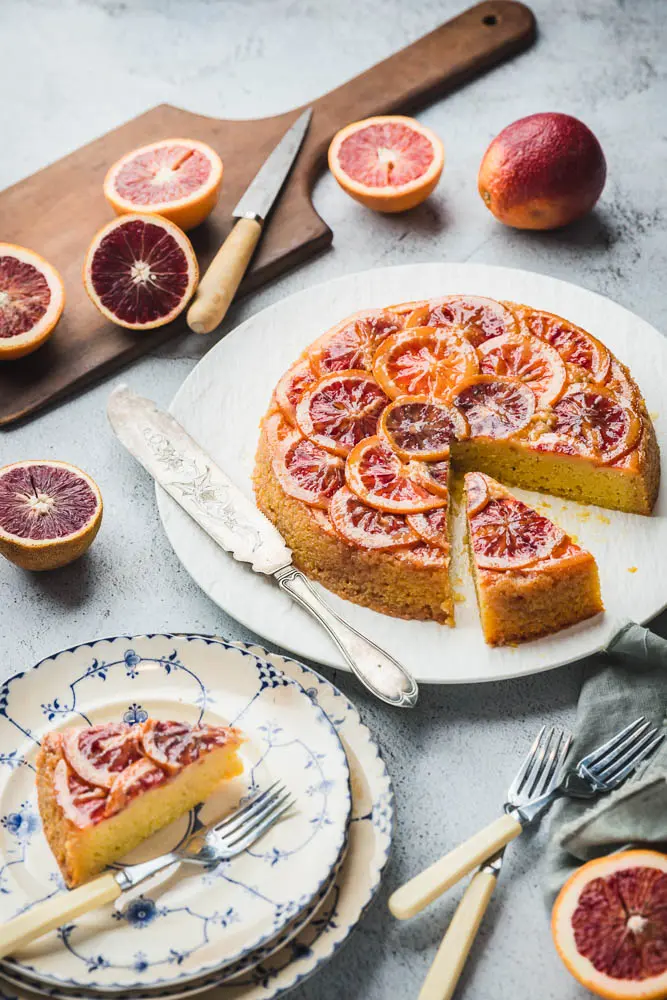
The sponge layer
The moistness of this cake comes from the almond flour, but also sour cream (or yogurt). To start, whisk the almond flour, all-purpose flour, baking powder and salt together in a medium bowl. No need to go crazy but make sure there aren’t any lumps. Set the bowl aside.
Like most cakes, start the batter by creaming the butter and sugar together until it becomes very light and fluffy. It’s essential that your butter is room temperature or you won’t be able to incorporate the tiny air pockets that give the cake volume and an even texture. This can take 3 to 4 minutes using the paddle attachment of a stand mixer and maybe around 6 to 7 minutes with a handheld beater. Scrape down the bowl as often as you need so that everything is evenly combined.
Next add the eggs, one at a time, and beat to incorporate each egg before adding the next one. Once that’s done, add the sour cream (or yogurt), the reserved orange zest and lemon zest and lemon juice. Beat the mixture once again to fully mix it together.
TIP: Don’t worry if the batter looks a little bit curdled from the lemon juice. It will bake up fine!
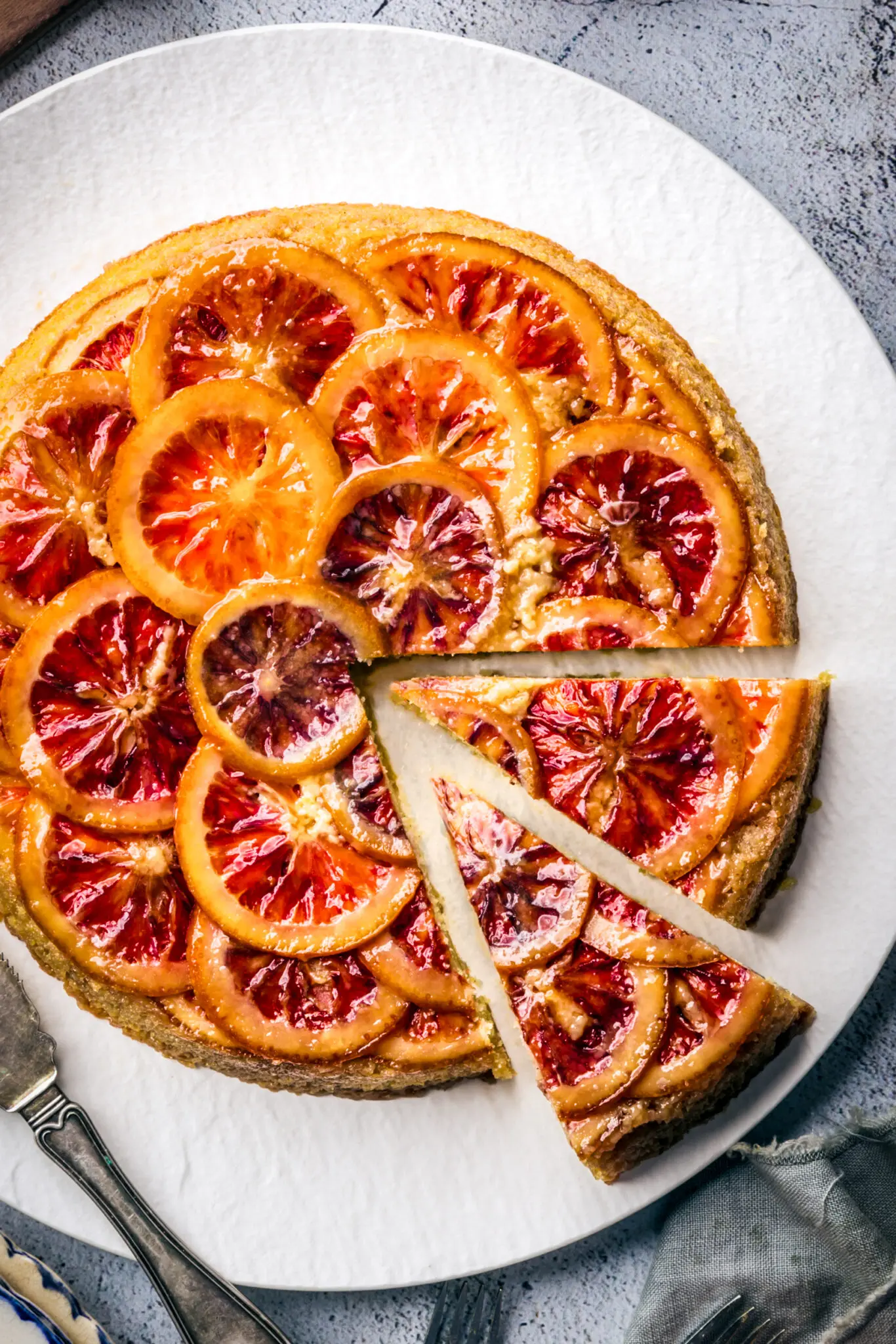
Now you’re ready to add the dry ingredients. Take the bowl off the mixer and use a silicone spatula to fold the dry ingredients in by hand. Make sure to scrape the bottom and sides of the bowl to ensure the flour mixture is fully and evenly mixed in. Pour the batter into the cake pan over the oranges, taking care not to shift them and mess up your pattern. The cooled caramel should keep them pretty set where you placed them. Smooth the top of the batter and place the cake pan on top of a foil-lined baking sheet. This will catch any drips if the caramel overflows.
Bake in a 350ºF oven until the top is golden brown and a toothpick inserted in the center comes out clean. The edges of the cake should be slightly darker brown and pulled away from the sides of the pan a little. This should take between 40 to 50 minutes.
When it’s ready, remove the cake from the oven onto a cooling rack, and let it sit for 10 minutes. Run a sharp knife around the edges of the pan to loosen any stuck bits. Place a serving plate on top of the cake pan and carefully flip the cake and the plate together. (This is your “ta-daaaa!” moment. If it turns into an “oh no!” moment, no matter. It’ll still be delicious.) The cake will be difficult to move once it’s out of the pan so make it as centered as you can as you flip, if you care about such things. Lift off the pan and the parchment and let the cake cool completely before serving.
We found the cake to be even better the next day so once it’s cool, it can be covered in plastic wrap and refrigerated until you’re ready to serve it. If you like a super shiny top, brush a little thinned apricot jam over the oranges just before serving. This cake is great with a little dollop of lightly sweetened whipped cream or yogurt on top.

Blood Orange and Almond Upside-down Cake
Equipment
- Mandoline optional
- Microplane zester
- 9-inch cake pan
Ingredients
- 2 to 3 medium-sized blood oranges
- 270 grams unsalted butter 2 sticks plus 3 tablespoons, room temperature, divided (plus more for greasing pan)
- 130 grams light brown sugar
- 122 grams fine almond flour
- 65 grams all-purpose flour
- 8 grams baking powder about 1 1/2 teaspoons
- 2 grams kosher or sea salt about 1/2 teaspoon
- 200 grams sugar about 1 cup
- 4 large eggs room temperature
- ⅓ cup sour cream or yogurt room temperature
- 2 teaspoons finely grated lemon zest from 1 large lemon
- 2 tablespoons lemon juice from the zested lemon
- 2 teaspoons vanilla extract or 1 teaspoon almond extract
Optional:
- 2 tablespoons apricot jam
- Lightly sweetened whipped cream or yogurt
Instructions
- Heat the oven to 350°F (325 with fan) and set an oven rack in the center position. Grease the bottom and sides of 9-inch round cake pan. Line the bottom of the pan with a round of parchment paper and coat it with more butter. Set the pan aside.
- Finely grate zest from one orange (about 2 teaspoons), and set zest aside. Slice off the tops of the oranges to expose the fruit and use a sharp knife, or even better, a mandolin, to slice oranges into very thin (1/8-inch) rounds. Remove and discard any seeds and repeat with all the oranges (you should have about 15 or 20 slices total).
- Squeeze 1 tablespoon of juice from the reserved ends of the oranges and add to a small saucepan. Add 3 tablespoons (45 grams) butter, and the brown sugar. Turn heat to medium and stir until sugar melts, about 3 minutes. Scrape mixture into prepared pan and tilt in all directions to spread across the parchment. Arrange the orange slices in an overlapping pattern across the bottom of the pan and set aside.
- In a large bowl, whisk together the almond flour, all-purpose flour, baking powder and salt. In a stand mixer fitted with the paddle attachment (or in a large bowl if using a hand mixer), cream together the remaining 2 sticks (225 grams) butter with granulated sugar until light and fluffy, about 3 to 4 minutes. Scrape down sides and bottom of bowl as needed. Beat in eggs, one a time, letting each fully incorporate before adding the next. Add sour cream, reserved orange zest and lemon zest, lemon juice and vanilla and beat until fully mixed. Gently fold in the dry mixture by hand, scraping the bottom and sides of the bowl to make sure all the flour is incorporated. The batter might look a little curdled from the addition of lemon juice – this is normal!
- Gently scrape the batter over the blood orange slices, being careful not to shift them, and smooth the top. Place the cake on a baking sheet to catch any drips and transfer to the oven. Bake until cake is golden brown and a toothpick inserted in the center emerges clean, 40 to 50 minutes. Transfer the pan to a wire rack and let the cake cool for 10 minutes. Run a thin knife around the edges of the pan to loosen it then invert onto a platter and remove parchment. Allow to cool completely before serving.
- If you want a super shiny top, add apricot jam to a small bowl and mix with 1 teaspoon hot water to loosen. Brush the glaze over the oranges. Slice and serve with whipped cream or yogurt.

